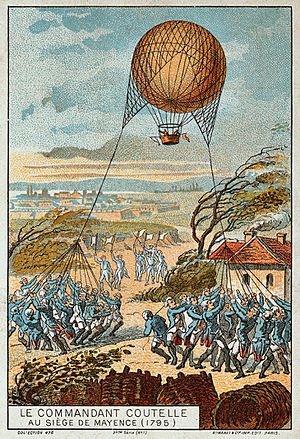Battle of Mainz facts for kids
Quick facts for kids Battle of Mainz |
|||||||
|---|---|---|---|---|---|---|---|
| Part of the War of the First Coalition | |||||||
 Reconnaissance during the French siege of Mainz, 1795 |
|||||||
|
|||||||
| Belligerents | |||||||
| Commanders and leaders | |||||||
| Strength | |||||||
| 33,000 | 27,000 | ||||||
| Casualties and losses | |||||||
| 3,000 killed or wounded 1,800 captured 138 cannons lost |
1,400 killed or wounded 200 captured |
||||||
The Battle of Mainz happened on October 29, 1795. It was a big fight near the city of Mainz in what is now Germany. This battle was part of a larger conflict called the War of the First Coalition.
In this battle, the Austrian army, led by Count of Clerfayt, launched a surprise attack. They fought against the French Army of Rhin-et-Moselle, which was commanded by François Ignace Schaal.
The French troops were caught off guard and had to retreat. They lost many soldiers and a lot of their cannons. This victory helped the Austrians push the French army further south.
Contents
What Happened at Mainz?
For many months, French soldiers had been trying to capture the western side of Mainz Fortress. This siege started in December 1794. However, they weren't very successful.
In September 1795, another French army, the Army of Sambre-et-Meuse, crossed the Rhine River. This army was led by Jean-Baptiste Jourdan. They moved south towards the Main River.
For a short time, Mainz was surrounded on both sides of the river. But this didn't last long. After another battle, the Austrians, led by Clerfayt, forced Jourdan's army to go back across the Rhine.
With Jourdan's army out of the way, Clerfayt's Austrian forces attacked Schaal's French troops. The French were forced to retreat south. This battle was a big win for the Austrians.
Interesting Fact: Balloons in Battle
The siege of Mainz was one of the first times that balloon reconnaissance was used in war. This means people went up in hot air balloons to look at the enemy's positions from above. The first time this happened was during the Battle of Fleurus in 1794.
Key People Involved
Many important military leaders were part of the events around the Battle of Mainz. Here are some of them:
- François Sebastien Charles Joseph de Croix, Count of Clerfayt: The main Austrian commander.
- Jean Baptiste Kléber: A French general.
- Laurent de Gouvion-Saint-Cyr: Another French general.
- Gabriel Jean Joseph Molitor: A French general.
- Adam Albert von Neipperg: An Austrian general.
- Antoine Christophe Merlin: A French general.
- Auguste de Marmont: A French general.
- Jean Bernadotte: A French general who later became a king.
- Franz von Weyrother: An Austrian staff officer.
- Franz Joseph, Marquis de Lusignan: An Austrian general.
- François, marquis de Chasseloup-Laubat: A French engineer.
- François Séverin Marceau-Desgraviers: A French general.
- Jean-Marie-Joseph Coutelle: A French balloonist.
- Joseph Marie, Count Dessaix: A French general.
- Nicolas-Jacques Conté: A French scientist and artist who worked on balloons.
- Paul Louis Courier: A French writer and soldier.
Military Units in the Battle
Different military groups fought on both sides. Here are a couple of examples:
- The 54th Infantry Regiment (France): A French infantry unit.
- Hessian soldiers: These were German soldiers who often fought for other countries. They were led by Colonel Johann Keglevich. He was recognized for his bravery in battle.
Images for kids


